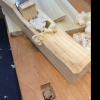I want to get a jointer for edge prep and to play around with stock surfacing. My work ranges in size from jewelry box sizes to larger cabinets. Initial lumber size tends to be 5/4 & ~5" wide and I tend to work with white oak, maple, and cherry. What's the practical differences between a #7, #8, and a low angle jointer (LN, etc.)? Is a 45° frog versus a 55° frog going to make a big difference given my usage?




 Reply With Quote
Reply With Quote








